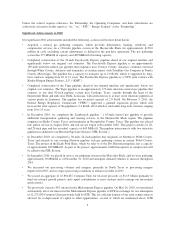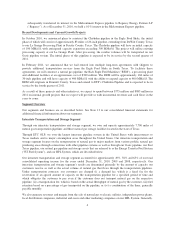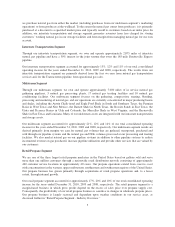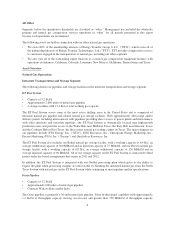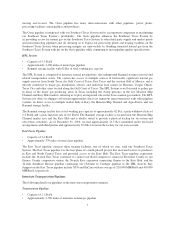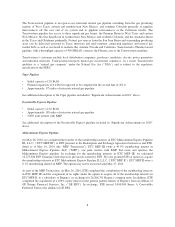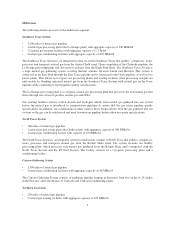Energy Transfer 2010 Annual Report Download - page 15
Download and view the complete annual report
Please find page 15 of the 2010 Energy Transfer annual report below. You can navigate through the pages in the report by either clicking on the pages listed below, or by using the keyword search tool below to find specific information within the annual report.Natural gas transportation.Natural gas transportation pipelines receive natural gas from other mainline
transportation pipelines and gathering systems and deliver the natural gas to industrial end-users, utilities and
other pipelines.
Competition
The business of providing natural gas gathering, compression, treating, transporting, storing and marketing
services is highly competitive. Since pipelines are generally the only practical mode of transportation for natural
gas over land, the most significant competitors of our transportation and storage segment are other pipelines.
Pipelines typically compete with each other based on location, capacity, price and reliability.
We face competition with respect to retaining and obtaining significant natural gas supplies under terms
favorable to us for the gathering, treating and marketing portions of our business. Our competitors include major
integrated oil companies, interstate and intrastate pipelines and companies that gather, compress, treat, process,
transport and market natural gas. Many of our competitors, such as major oil and gas and pipeline companies,
have capital resources and control supplies of natural gas substantially greater than ours.
In marketing natural gas, we have numerous competitors, including marketing affiliates of interstate pipelines,
major integrated oil companies, and local and national natural gas gatherers, brokers and marketers of widely
varying sizes, financial resources and experience. Local utilities and distributors of natural gas are, in some cases,
engaged directly, and through affiliates, in marketing activities that compete with our marketing operations.
Credit Risk and Customers
We maintain credit policies with regard to our counterparties that we believe significantly reduce overall credit
risk. These policies include an evaluation of potential counterparties’ financial condition (including credit
ratings), collateral requirements under certain circumstances and the use of standardized agreements, which
allow for netting of positive and negative exposure associated with a single counterparty.
Our counterparties consist primarily of petrochemical companies and other industrials, mid-size to major oil and
gas companies and power companies. This concentration of counterparties may impact our overall exposure to
credit risk, either positively or negatively, in that the counterparties may be similarly affected by changes in
economic, regulatory or other conditions. Currently, management does not anticipate a material adverse effect on
financial position or results of operations as a result of counterparty performance.
Our natural gas transportation and midstream revenues are derived significantly from companies that engage in
natural gas exploration and production activities. Prices for natural gas and NGLs have been negatively impacted
in recent years by economic conditions and the discovery and development of new shale formations. As a result,
many of our customers have been negatively impacted. We are diligent in attempting to ensure that we issue
credit to credit-worthy customers. However, the purchase and resale of natural gas exposes us to credit risk, as
the margin on any sale is generally a small percentage of the total sales price. Therefore, a credit loss could be
significant to our overall profitability.
During the year ended December 31, 2010, none of our customers individually accounted for more than 10% of
our midstream, intrastate transportation and storage and interstate segment revenues.
Regulation
Regulation by the FERC of Interstate Natural Gas Pipelines. The FERC has broad regulatory authority over
the business and operations of interstate natural gas pipelines. Under the NGA, the FERC generally regulates the
transportation of natural gas in interstate commerce. For FERC regulatory purposes, “transportation” includes
natural gas pipeline transmission (forwardhauls and backhauls), storage and other services. The Transwestern and
Tiger pipelines transport natural gas in interstate commerce and thus both pipelines qualify as a “natural gas
13


